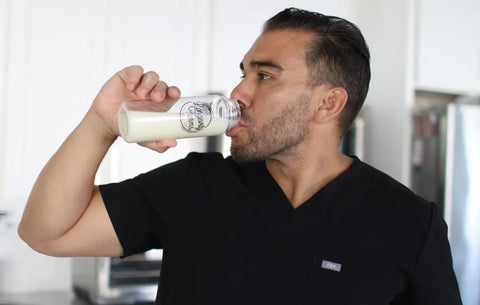In recent years, NAD restoration therapy has emerged as a promising concept in longevity science. The goal is to restore NAD levels in the body, which naturally decline with age, potentially improving health and slowing certain aspects of aging. A range of clinical approaches for NAD replenishment has gained traction in the US, from dietary supplements to IV infusions. This article provides a comprehensive overview of NAD+, its importance in aging and health, and the emerging clinical methods for boosting NAD+ levels.
What is NAD+? Understanding the Molecule of Vitality
It stands for nicotinamide adenine dinucleotide, a coenzyme found in every cell of the body. It plays a central role in cellular energy metabolism, acting as a key electron transporter in reactions that generate ATP (the cell’s energy currency). NAD+ (the oxidized form) also serves as a helper molecule for numerous enzymes involved in repairing DNA, regulating stress responses, and maintaining proper cell signaling. The various NAD benefits for cellular function include supporting energy production, DNA repair mechanisms, and healthy mitochondrial function.

There are two interconvertible forms: NAD+ and NADH (the reduced form). NAD+ accepts electrons during metabolic reactions and becomes NADH, which then donates electrons to help power the mitochondria (the cell’s power plants) to make ATP. Beyond energy metabolism, NAD+ is also crucial for activating proteins that fix damaged DNA and for enzymes that regulate our circadian rhythm and inflammation levels. Having abundant NAD+ allows these processes to run smoothly, which is why scientists believe maintaining NAD+ is essential for health and longevity.
NAD+ and Aging: The Link Between NAD and Age-Related Decline
A growing body of research highlights a strong connection between NAD+ levels and the aging process. Scientists studying NAD aging have observed that NAD+ levels steadily decline as we get older, leaving cells with a dwindling supply of this vital coenzyme. By middle age, NAD+ concentrations in tissues can drop significantly compared to those in youth, and this decline is thought to contribute to age-related functional declines. A wealth of evidence indicates that an age-related decline in cellular NAD+ is a hallmark of aging and may actively drive the aging process. Low NAD+ makes it harder for cells to repair DNA damage, cope with oxidative stress, and maintain their normal metabolism.
Why do NAD+ levels drop with age? One major reason is increased consumption of NAD+ by enzymes involved in repair and stress responses. As we age, we accumulate more DNA damage and cellular stress, which activate NAD-consuming enzymes, such as poly(ADP-ribose) polymerases (PARPs) and sirtuins. These enzymes use up NAD+ to carry out repairs and regulatory processes. Also, chronic inflammation in aging can overactivate an enzyme called CD38, which breaks down NAD+. On the production side, the body’s ability to recycle NAD+ precursors via the salvage pathway may become less efficient with age. The net effect is a persistent NAD+ deficit in older cells. This NAD+ decline is significant because it leaves cells less equipped to handle metabolic demands and control damage. For example, if DNA repair enzymes lack NAD+, DNA damage can accumulate more rapidly, potentially contributing to the development of cancer and tissue dysfunction.
NAD+, Oxidative Stress, and Cellular Protection
Oxidative stress occurs when there’s an imbalance between the production of harmful free radicals (reactive oxygen species) and the body’s ability to neutralize them with antioxidants. Over time, this imbalance can damage cellular components, including DNA, proteins, and lipids, thereby undermining cell health and accelerating the aging process. NAD+ plays a central role in mitigating oxidative stress through several interconnected mechanisms. As mentioned, NAD+ is essential for the activity of sirtuins and PARPs—enzyme families that help repair DNA damage and regulate cellular stress responses. When NAD+ levels are sufficient, these enzymes can efficiently identify and repair oxidative lesions in DNA, helping cells recover from daily wear and tear.
NAD+ Restoration and Cognitive Health: Memory, Focus, and Mental Clarity
One of the most intriguing areas of research into NAD restoration therapy is its potential to support cognitive and brain health, including memory, focus, and mental clarity. As we age, it’s common to experience subtle declines in these mental faculties—slower recall, diminished concentration, and occasional mental fog. Scientists believe that declining NAD+ levels may play a direct role in these changes, given the molecule’s central importance in the brain’s cellular processes.
NAD+ is vital for neuronal energy metabolism; brain cells (neurons) are among the most energy-demanding in the body, and they rely on a continuous supply of ATP to transmit signals, process information, and maintain synaptic connections. NAD+ acts as a key coenzyme in the mitochondrial reactions that generate this ATP, ensuring that neurons have the fuel they need to function optimally. When NAD+ levels drop, neuronal energy production can falter, potentially leading to impaired neurotransmission and cognitive sluggishness.
Beyond energy production, NAD+ is also crucial for DNA repair within brain cells. Neurons are particularly susceptible to DNA damage due to their high metabolic activity and extended lifespan. The brain’s ability to repair this damage depends on enzymes like PARPs, which require NAD+ to function. If NAD+ is depleted, DNA repair processes slow down, allowing cellular errors to accumulate and increasing the risk of neuronal dysfunction or death. This is particularly relevant in the context of neurodegenerative diseases, where impaired DNA repair and mitochondrial dysfunction are common features. Additionally, NAD+ is essential for the activation of sirtuins—a family of enzymes that regulate cellular stress responses, inflammation, and synaptic plasticity (the brain’s ability to adapt and form new connections). Sirtuins have been linked to improved learning, memory formation, and resistance to age-related cognitive decline, but they can only function in the presence of sufficient NAD+.

NAD+ Restoration and Pain Management: Easing Discomfort and Supporting Comfort
NAD restoration therapy may play a role in reducing pain levels and improving overall comfort, especially in older adults. Chronic pain—often linked to inflammation, oxidative stress, and cellular dysfunction—affects a significant portion of the aging population. NAD+ is a key coenzyme involved in cellular repair processes and the regulation of inflammatory responses. When NAD+ levels decline with age, the body’s ability to manage inflammation and repair tissue damage becomes compromised, potentially leading to increased pain and discomfort. By restoring NAD+ levels through supplementation or intravenous therapy, it may be possible to enhance the body’s natural mechanisms for controlling inflammation and supporting cellular repair. Some practitioners and early studies have reported that individuals receiving NAD therapy experience relief from joint pain, muscle aches, or general discomfort, likely due to improved cellular resilience and reduced inflammatory signaling.
Why Restore NAD+ Levels? Potential NAD Therapy Benefits
Given NAD+’s central role in cell function, it’s no surprise that boosting NAD+ is being explored as a strategy to improve healthspan (the healthy years of life). The potential benefits of NAD IV therapy are wide-ranging. In animal studies, increasing NAD+ has produced remarkable anti-aging effects: older mice treated with NAD+ precursors regained a more youthful metabolism, with improvements in insulin sensitivity, exercise endurance, and cognitive function. Scientists have reported that restoring NAD+ in aged mice can improve cardiovascular health, enhance muscle strength, and even partially restore vision in models of retinal degeneration. These findings suggest that high NAD+ levels help cells and organs function as if they were younger. NAD+ upregulation (through supplements or other means) may support healthy aging and help delay or mitigate chronic diseases.
Approaches to Restore NAD Levels: How Can We Increase NAD+?
There are several approaches, ranging from lifestyle adjustments to high-tech clinical interventions. Here are the main strategies being used or investigated to restore NAD levels:
-
Healthy Lifestyle and Diet: Interestingly, some NAD restoration therapy begins with simple lifestyle choices. Exercise and caloric restriction have been shown to naturally elevate NAD+ levels by activating the NAD+ salvage pathway and important enzymes like AMPK. A diet rich in vitamin B3 (niacin) and tryptophan provides building blocks for NAD+ synthesis as well. While these measures alone may not dramatically boost NAD+ in someone older, they set a foundation for maintaining NAD+.
-
NAD Precursor Supplements: This is currently the most popular and accessible approach. NAD supplements don’t contain NAD+ itself. Instead, supplements provide NAD precursor supplements – compounds that our cells can readily convert into NAD+. Two of the leading NAD precursors are NR (nicotinamide riboside) and NMN (nicotinamide mononucleotide). These are forms of vitamin B3 that enter the NAD+ production pathway (specifically, the “salvage pathway” that recycles NAD). Taking these precursors in pill or powder form has been shown to raise NAD+ levels in the bloodstream and tissue to some degree. For example, NR and NMN supplements at typical doses can increase blood NAD+ by about 40–60%, though higher doses may be needed to substantially exceed that. Because NAD+ itself is not bioavailable orally, using precursors like NR or NMN is the key strategy to boost NAD+ from the inside effectively.
-
Direct NAD+ Delivery: Another approach bypasses the digestive system altogether by delivering NAD+ directly into the bloodstream. NAD+ IV therapy involves infusing NAD+ intravenously so cells can take it up from the blood. Clinics and wellness centers offer NAD+ IV drips as a way to replenish the body's NAD+ levels rapidly. Each session can take several hours as the NAD+ solution is slowly infused. There are also emerging methods like subcutaneous NAD+ injections or patches, but IV infusion is the most common direct delivery method today. The idea here is to provide NAD+ directly to tissues, potentially achieving higher levels than oral supplements can, at least temporarily.
-
Emerging Novel Therapies: Scientists are also exploring other innovative ways to sustain NAD+ levels. One target is to reduce NAD+ consumption by inhibiting NAD-degrading enzymes (like CD38 or PARP) – essentially slowing the “leak” of NAD+. Experimental drugs that block CD38, for instance, have shown they can raise NAD+ and improve metabolic health in animal models. Another approach under study is gene therapy or activation of certain genes (like the one for NAMPT, a key NAD-synthesizing enzyme) to increase the body’s own NAD+ production. While these are not yet clinical treatments, they represent the next generation of NAD restoration strategies that could complement or enhance precursor supplementation.
Choosing the Best NAD Booster: Supplements vs. IV Therapy
With multiple ways to raise NAD+, how do you choose the approach that’s right for you? There is no one-size-fits-all answer for the best NAD booster – it depends on individual preferences, health status, and goals:
-
Convenience: NAD precursor supplements clearly win on convenience. Swallowing a pill (or a scoop of powder) each day is easy to fit into a routine, whereas NAD IV therapy at home requires setting aside hours. If you have a busy lifestyle, daily supplements or lifestyle measures are far less disruptive than IV infusions. On the other hand, if you are seeking a one-time jumpstart, an IV might be appealing despite the inconvenience, as a sort of occasional tune-up.
-
Cost: Oral supplements are much more affordable. A month’s supply of a quality NMN or NR supplement might run from $30 to $100, depending on the dose and brand. Meanwhile, a single NAD IV treatment can cost several times that. Over the long term, supplements are the only practical choice financially for most people. NAD IV therapy’s high cost makes it something usually reserved for short-term protocols or for those with substantial disposable income invested in wellness hacks.
-
Health Goals: Your specific health objectives might also guide the choice. If your aim is general longevity and prevention, a steady daily supplement combined with exercise and a good diet is a prudent approach. If you are addressing something more immediate – perhaps recovering from surgery, intense training, or dealing with fatigue that hasn’t improved with other methods – you might experiment with a short course of NAD IV under medical supervision to see if you feel a difference. Always set realistic expectations: NAD boosters are not a magic bullet or a substitute for overall healthy living.
If you’re considering any NAD-boosting therapy, it’s wise to consult with a healthcare provider knowledgeable about integrative or longevity medicine. They can help tailor an approach and monitor any effects.
Suitability and Safety Considerations
Generally, NAD therapy is being explored by adults looking to counteract age-related declines in energy, resilience, and cellular function. People experiencing persistent fatigue, low energy, or unexplained sluggishness may find NAD restoration particularly appealing, as replenishing NAD+ can help support mitochondrial function and overall vitality. Certain populations may have unique reasons to consider NAD therapy. For example, individuals with a history of substance abuse or those recovering from addiction have been shown to benefit from NAD’s role in supporting neurological function and easing withdrawal symptoms. People living with chronic stress, anxiety, or mood disorders may also be interested in NAD therapy due to its involvement in cellular repair and stress response pathways.

A notable group that has garnered attention in the context of NAD therapy is those with metabolic conditions such as diabetes. While NAD restoration therapy does not directly lower blood glucose levels, it may help diabetics by supporting metabolic health, boosting organ function, and potentially reducing the risk of complications like fatty liver disease. Maintaining healthy NAD+ levels is believed to enhance the function of vital organs, including the liver, kidneys, and heart, which is particularly relevant for individuals managing chronic conditions. As always, those with diabetes or other complex health issues need to consult closely with their healthcare provider before starting NAD therapy, as individual needs and responses can vary.
When considering NAD restoration therapy, safety is a key factor. NAD+ is a naturally occurring molecule found in every cell, and clinical approaches such as oral NAD precursor supplements and IV infusions are generally well-tolerated. Reported side effects are typically mild and may include headache, nausea, dizziness, or flushing, especially with intravenous administration.
NAD+ is a critical molecule for healthy cell function, and its decline with age opens the door to interventions to replenish it. NAD restoration therapy – through supplements, NAD IV drips, or future innovations – represents an emerging clinical approach aimed at bolstering our cellular vitality as we age. While early results are promising and many people report positive experiences, it’s essential to approach these therapies with a balanced perspective. The science is young, and more evidence will help clarify who benefits most and how to implement NAD best boosting. If you decide to experiment with NAD therapies, do so safely: source quality products, involve healthcare professionals, and pay attention to your body’s responses. NAD+ may indeed be a key to unlocking better health in our later years, but it’s just one piece of the complex puzzle of aging and wellness.
Sources:
-
MDLinx – “Is NAD therapy all it’s cracked up to be? Here’s the evidence.” (2025) mdlinx.com
-
Verywell Health – “Do NAD+ Infusions Really Slow Down Aging?” (2023) verywellhealth.com
-
Conlon NJ et al. – “The Role of NAD+ in Regenerative Medicine.” Plast. Reconstr. Surg. 150(4S):41S-48S (2022) pmc.ncbi.nlm.nih.gov
-
Henderson J et al. – “The use of a systems approach to increase NAD+ in human participants.” NPJ Aging 10, 7 (2024) nature.com




